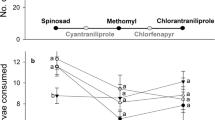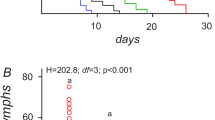Abstract
An attempt was made to achieve low environmental risk control of insect pests using sublethal concentrations of insecticides, enhanced by the effect of high temperatures (>25°C). For each of the insecticides imidacloprid, abamectin, pirimicarb and azadirachtin, the lethal and sublethal concentrations were determined for the green peach aphidMyzus persicae (Sulzer) (Homoptera: Aphididae) and its predator, the lady beetleHarmonia axyridis (Pallas). The lady beetle was more tolerant of all four insecticides, as well as of high temperatures below 40°C, compared with the prey. The joint action of sublethal concentrations of insecticides and high temperatures was investigated to determine the sublethal concentrations and temperatures that would be effective in controlling the aphids, but not detrimental to the beneficial lady beetle. The results suggested a synergistic effect of sublethal insecticide concentrations and high temperatures against the green peach aphid.
Similar content being viewed by others
References
Alexandrescu, S. (1986) Influence of temperature on the toxicity of synthetic pyrethroid insecticides.An. Inst. Cercet. Prot. Plant. 19:213–219.
Ayad, F.A. and Alyousef, E.F. (1984) Effect of temperature on the efficiency of some insecticides against the cowpea weevilCallosobruchus maculatus (Fab.) (Coleoptera: Bruchidae).Bull. Entomol. Soc. Egypt 14:329–385.
Bensadia, F., Boudreault, S., Guay, J.F., Michaud, D. and Cloutier, O. (2006) Aphid clonal resistance to a parasitoid fails under heat stress.J. Insect Physiol. 52:146–157.
Chandler, D.R., King, R.G., Jewess, P. and Reynolds, S.E. (1991) Temperature effects on the action of acylurea insecticides against tobacco hornworm (Manduca sexta) larvae.Pestic. Sci. 31:295–304.
Cho, K.J., Uhm, K.B. and Lee, J.O. (1999) Effect of test leaf and temperature on mortality ofFrankliniella occidentalis in leaf dip bioassay of insecticides.J. Asia-Pac. Entomol. 2:69–75.
Dittrich, V.A. (1962) Comparative study of toxicological test methods on a population of the two-spotted spider mite (Tetranychus telarius).J. Econ. Entomol. 55:644–648.
El-Sayed, G.N. and Knowles, C.O. (1984) Formamidine synergism of pyrethroid toxicity to two spotted spider mites (Acari: Tetranychidae).J. Econ. Entomol. 77:23–30.
Everts, J.W., Willemsen, I., Stulp, M., Simons, L., Aukema, B. and Kammenga, J. (1991) The toxic effects of deltamethrin on linyphiid and erigonid spiders in connection with ambient temperature, moisture, and predation.Arch. Environ. Contam. Toxicol. 20:20–24.
Ffrench, C.R.H., Steichen, J.C. and Ode, P.J. (1993) Cyclodiene insecticide resistance inDrosophila melanogaster (Meigen) is associated with a temperature-sensitive phenotype.Pestic. Biochem. Physiol. 46:73–77.
Finney, D.J. (1952) Probit Analysis. Cambridge University Press, London, UK.
Guillebeau, L.P., All, J.N. and Javid, A.M. (1989) Influence of weather on efficacy of pyrethroid insecticides for boll weevil (Coleoptera: Curculionidae) and bollworm (Lepidoptera: Noctuidae) in cotton.J. Econ. Entomol. 82:291–297.
Hogmire, H.W., Brown, M.W. and Crim, V.L. (1990) Toxicity of slide dip application of five insecticides to apple aphid and spirea aphid (Homoptera: Aphididae).J. Entomol. Sci. 25:10–15.
Morytz, B., Przybysz, E. and Kroczynski, J. (1997) Insect response to toxicity of some insecticides in the temperature range 15–35°C.Prog. Plant Prot. 37:77–80 (Polish, with English abstract).
Rahman, G.M., Mahbub, S.M., Hawlader, A.J. and Shahjahan, R.M. (1999) Larvicidal effects of three common insecticides against mosquitoAedes aegypti (L.) (Diptera: Culicidae) at two temperature regimes.Bangladesh J. Entomol. 9:131–136.
Rameshwar, S., Kavadia, V.S. and Singh, R. (1990) Effect of environmental factors on the residual toxicity and persistence of insecticides. III. Effect of temperature and humidity on the residual toxicity of insecticides.Indian J. Entomol. 51:450–457.
SAS (2006) SAS OnlineDoc®. Version 9.1.3. SAS Institute Inc., Cary, NC, USA. http://support.sas.com/onlinedoc/913/docMainpage.jsp.
Turnbull, S.A. and Harris, R.C. (1986) Influence of posttreatment temperature on the contact toxicity of ten organophosphorus and pyrethroid insecticides to onion maggot adults (Diptera: Anthomyiidae).Proc. Entomol. Soc. Ont. 117:41–44.
Whiting, D.C., Jamieson, L.E. and Connolly, P.G. (1999) Effect of sublethal tebufenozide applications on the mortality responses ofEpiphyas postvittana (Lepidoptera: Tortricidae) larvae exposed to a high-temperature controlled atmosphere.J. Econ. Entomol. 92:445–452.
Author information
Authors and Affiliations
Corresponding author
Additional information
http://www.phytoparasitica.org posting Aug. 5, 2007.
Rights and permissions
About this article
Cite this article
Wang, Xy., Shen, Zr. Potency of some novel insecticides at various environmental temperatures onMyzus persicae . Phytoparasitica 35, 414–422 (2007). https://doi.org/10.1007/BF02980705
Received:
Accepted:
Issue Date:
DOI: https://doi.org/10.1007/BF02980705




